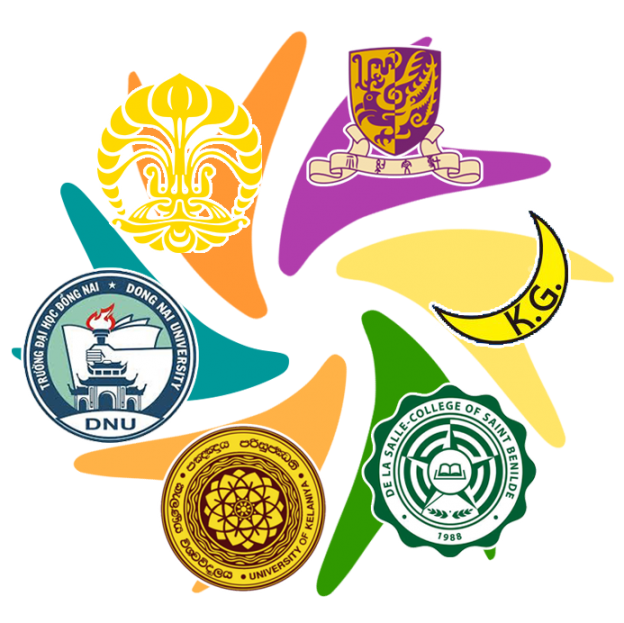In this and the next module, we will look at classifier constructions in sign languages. Most of the sign languages studied to date are reported to have this kind of constructions (Zwitserlood, 2012). Classifier constructions are complex morphological structures that are visually and spatially iconic, and involve simultaneous combinations of different morphemes.
To understand the characteristics of classifier constructions in sign languages, we first need to have a basic understanding of what classifiers are in spoken languages. A classifier is a morpheme (i.e., smallest meaningful unit in a language) that denotes some salient characteristics of an entity to which an associated noun refers (Allan, 1977). Classifiers are found in many unrelated and geographically separated spoken languages. Cantonese, a Chinese language variety, is a classifier language which requires an obligatory use of classifier morphemes in nominal expressions when numerals are present. Example 1 to 3 show three Cantonese nominal expressions, each consisting of a numeral, a classifier, and a noun. Gaa3 in Example 1 is a classifier for vehicles. Apart from ce1 (“car”), gaa3 can be used with vehicles such as airplane, bus, train, bicycle, and tank. Tiu4 in Example 2 denotes entities that are elongated and thin, and it can be used with nouns such as snake, hair, water pipe, river, and rainbow. Baa2 in Example 3 denotes objects that have a handle for a human hand to grasp, and it can be used with nouns such as knife, gun, ruler, sword, and saw.
Example 1
saam1 gaa3 ce1
three CL-vehicle car
‘Three cars’
Example 2
jat1 tiu4 sing2
One CL-long-thin-object rope
‘one rope’
Example 3
loeng5 baa2 gaau3zin2
two CL-object-with-a-handle scissors
‘two (pairs of)scissors’
These bound morphemes are called classifiers because one of their functions is to subcategorize (i.e., grouping) the noun referents. Classifiers in languages offer us an interesting window to study how human minds conceptualize and categorize things they experience in the world. Examples of categorizations represented by classifiers in spoken languages include material, shape, size, arrangement, location, quantity, humanness, and animacy (Allan, 1977; Her et al., 2022). Within spoken languages that have a classifier system, the most common classifiers relate to humanness, animacy, long-shape, and round-shape (Croft, 1994).
In Cantonese, classifiers are used within nominal phrases. In some classifier languages, however, classifiers are attached to verbs. These spoken languages are known as predicate classifier languages in Allan’s typological study (1977). Example 4 is an example from Cayuga, a Native American language (Mithun, 1986, p. 386-388, as cited in Grinevald 2000; Sandler & Lillo-Martin, 2006). The classifier –treht- is attached to the verb –ae.
Example 4:
Skitu ake’-treht-ae’
Skidoo I – CL (vehicle) – have
‘I have a skidoo.’
Supalla (1982; 1986) was the first sign linguist who proposed that sign languages are similar to predicate classifier languages1. In sign languages, classifiers are handshape morphemes attached to verb roots that denote motion and location to form predicates. There are basically three major types of classifier handshapes in sign languages: Size and Shape Specifiers (SASSes), Entity Classifiers (also commonly known as Semantic Classifiers), and Handling Classifiers (Sandler & Lillo-Martin, 2006). In the remainder of this module, we will discuss examples of SASSes first. The remaining three classifier types will be discussed in the next module.
________________
1Over the past few decades there have been a lot of discussions in the literature concerning whether it is appropriate to analyze the iconic handshape morphemes in the predicates as classifiers. The verb-classifier combinations have also been given different names in the literature, e.g., spatial-locative predicates, polymorphemic predicates, productive signs, highly iconic structures, etc. Interested readers can refer to Zwitserlood (2012) and Sandler & Lillo-Martin (2006) for a more detailed discussion.
SASSes are handshapes that represent the physical appearance of objects.
Example 5
TABLE CL[=long flat object be located], BOOK CL[=flat object be located], RULER CL[= narrow, elongated, flat object be located], PENCIL CL[=short, elongated object be located]
‘There is a table, with a book, a ruler and a pencil on it.’
In Example 5 above, the signer first introduces the nominal TABLE, followed by a classifier predicate CL[=long flat object be located]. In this classifier predicate, the signer uses his forearm and palm, with a downward palm orientation, as a classifier for the table. This handshape is a bound morpheme, as it has to be combined with the other parameters, namely, movement, location, and orientation, in order to express the exact location of the table in the signing space. After that, the signer describes the locations of the three other objects one by one, each with a nominal expression followed by a classifier predicate. For the book, the classifier handshape is a flat B-handshape. For the ruler, the classifier handshape involves the extension of the middle and index fingers. The pencil is a short, elongated object and is represented by an extended index finger only. All four classifiers represent the physical appearance (i.e., size and shape) of the associated noun referents. As such, they belong to the category of SASSes.
All four SASSes in Example 5 are combined with locative verb roots to indicate where the objects are located. Classifier handshapes can be combined with motion verb roots, too. Example 6 below shows a ball-shaped SASS combined with a motion verb ‘bounce’:
Example 6
BALL CL[=ball bounces on ground]
‘A ball is bouncing on the ground.’
It is also possible for a signer to produce two different SASSes with their two hands, each representing a different referent. In Example 7, the signer first introduces the earth with a nominal, and uses a classifier predicate to anchor it in the signing space. This is followed by another clause about the moon and its location relative to the earth. Note that the classifier handshape of the moon is smaller than that of the earth. In the final clause, the hand that represents the moon classifier spins around the earth classifier.
Example 7
EARTH CL[=big round object be located], MOON CL[=small round object be located], CL[=small round object moves around the big round object]
‘The moon evolves around the earth.’
Table 1 below lists out some examples of SASS handshapes in HKSL and what they can stand for (Tang, 2007).
Table 1. Examples of SASS handshapes in HKSL
| SASS handshapes | What the SASSes may stand for |
(1.1)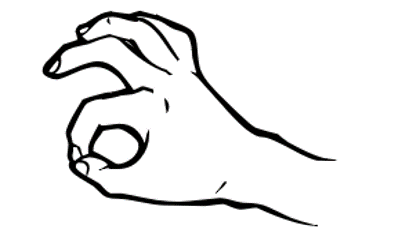 |
2-dimensional circular objects, e.g., large button, coin, an owl’s eye. |
(1.2)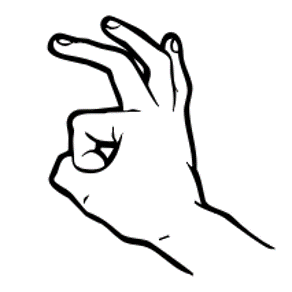 |
Very small objects, e.g., button, seed. |
(1.3)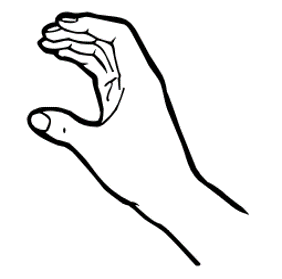 |
Cylindrical objects, e.g., cup/glass, soft drink can. |
(1.4)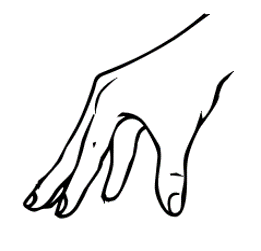 |
3-dimensional curved/cubic objects, or objects with a broader base e.g., bell, house, pyramid. |
(1.5)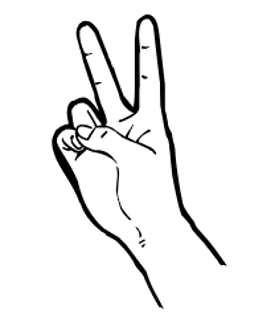 |
Objects with two long and narrow subparts connected at one hand, e.g., crab claws, scissors, and chopsticks. |
(1.6)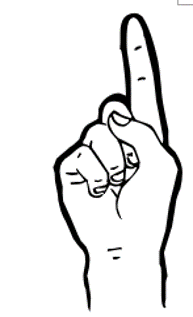 |
Linear objects, e.g., toothbrush, compass needle, knitting needle. |
SASSes tend to be similar across sign languages because they are visually iconic.
References:
- Allan, K. (1977). Classifiers. Language, 53, 285-311. https://doi.org/10.1353/lan.1977.0043 .
- Croft, W. (1994). Semantic universals in classifier systems. Word, 45(2), 145-171.
- Grinevald, C. (2000). A morphosyntactic typology of classifiers. In G. Senft (Ed.), Systems of nominal classification (pp. 50-92). Cambridge University Press.
- Her, O., Hammarström, H., & Allassonnière-Tang, M. (2022). Defining numeral classifiers and identifying classifier languages of the world. Linguistics vanguard, 8(1), 151-164. https://doi.org/10.1515/lingvan-2022-0006 .
- Mithun, M. (1986). The convergence of noun classification systems. In C. Craig (Ed.), Noun classes and categorization (pp. 379-197). John Benjamins.
- Supalla, T. (1982). Structure and acquisition of verbs of motion and location in American Sign Language. [PhD Dissertation, University of California].
- Supalla, T. (1986). The classifier system in American Sign Language. In C. Craig (Ed.), Noun classes and categorization (pp. 181-214). John Benjamins.
- Tang, G. (2007). Hong Kong Sign Language: A trilingual dictionary with linguistic descriptions. The Chinese University of Hong Kong.
- Zwitserlood, I. (2012). Classifiers. In R. Pfau, M. Steinbach, & B. Woll (Eds), Sign language: An international handbook (pp.158-185). De Gruyter.
![]()
